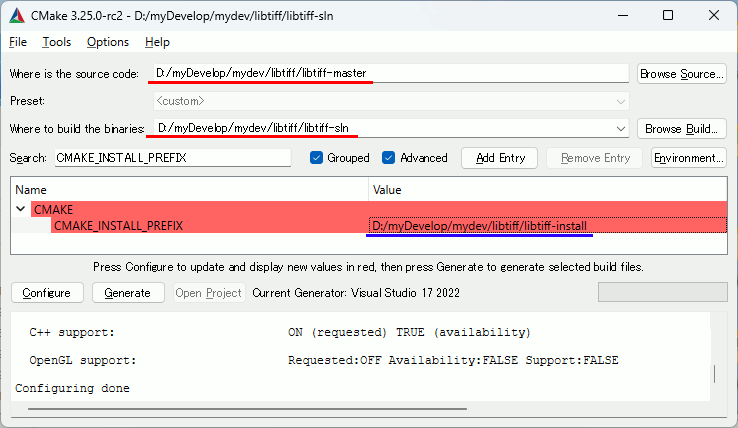スポンサーリンク
libtiffを使ってみる(1) CMake , 読み込み
CMake
CMakeはかなり楽。
Where is the source code: D:/myDevelop/mydev/libtiff/libtiff-master
Where to build the binaries: D:/myDevelop/mydev/libtiff/libtiff-sln
CMAKE_INSTALL_PREFIX: D:/myDevelop/mydev/libtiff/libtiff-install
slnを開いて、ALL_BUILD → INSTALL 。
テストコード
せっかくなのでTIFFTAG_PHOTOMETRIC や TIFFTAG_PLANARCONFIG を取得する例を書いているが使っていないので消していい。
#include <iostream> #ifdef _DEBUG #pragma comment(lib, "tiffd.lib") #else #pragma comment(lib, "tiff.lib") #endif #include <tiffio.h> #include <vector> #include <cassert> #pragma warning(disable:4996) void pnmP3_Write(const char* const fname, const int width, const int height, const unsigned char* const p); int main() { // tiffファイルの読み込み TIFF* tif = TIFFOpen("D:\\Data\\test.tif", "r"); if (tif == nullptr) { std::cout << "Error: Cannot open tiff file" << std::endl; return -1; } // tifデータの情報を取得 std::uint32_t width, height; std::uint16_t bits_per_sample, samples_per_pixel; std::uint16_t photometric; std::uint16_t planar_config; std::uint16_t sample_format; TIFFGetField(tif, TIFFTAG_IMAGEWIDTH, &width); // 画像の幅 TIFFGetField(tif, TIFFTAG_IMAGELENGTH, &height); // 画像の高さ TIFFGetField(tif, TIFFTAG_BITSPERSAMPLE, &bits_per_sample); // 1画素あたりのビット数 TIFFGetField(tif, TIFFTAG_SAMPLESPERPIXEL, &samples_per_pixel); // 1画素あたりのサンプル数 TIFFGetField(tif, TIFFTAG_PHOTOMETRIC, &photometric); // 画像のフォーマット TIFFGetField(tif, TIFFTAG_PLANARCONFIG, &planar_config); // 画像の格納形式 TIFFGetField(tif, TIFFTAG_SAMPLEFORMAT, &sample_format); // 画像のデータフォーマット // 8bitのみ対応 assert(bits_per_sample == 8); // RGBの場合はAは不透明に設定される assert(samples_per_pixel == 3 || samples_per_pixel == 4); size_t image_size = width * height; // 画像を読み込むためのバッファを作成 std::uint32_t* buffer = (std::uint32_t*)_TIFFmalloc(image_size * sizeof(std::uint32_t)); // 画像を保存するためのバッファを作成 std::vector<std::uint8_t> mydata(image_size * 3); // RGBの3チャンネルだけ使用 // 画像を読み込む if (TIFFReadRGBAImage(tif, width, height, buffer, 0)) { for (size_t i = 0; i < image_size; i++) { mydata[i * 3 + 0] = TIFFGetR(buffer[i]); mydata[i * 3 + 1] = TIFFGetG(buffer[i]); mydata[i * 3 + 2] = TIFFGetB(buffer[i]); } } _TIFFfree(buffer); // tiffオブジェクトを解放 TIFFClose(tif); pnmP3_Write("test.ppm", width, height, mydata.data()); std::cout << "Hello World!\n"; } ////////////////////////////////////////////////// ////////////////////////////////////////////////// ////////////////////////////////////////////////// ////////////////////////////////////////////////// //! @brief PPM(RGB各1byte,カラー,テキスト)を書き込む //! @param [in] fname ファイル名 //! @param [in] vmax 全てのRGBの中の最大値 //! @param [in] width 画像の幅 //! @param [in] height 画像の高さ //! @param [in] p 画像のメモリへのアドレス //! @details RGBRGBRGB....のメモリを渡すと、RGBテキストでファイル名fnameで書き込む void pnmP3_Write(const char* const fname,const int width, const int height, const unsigned char* const p) { // PPM ASCII FILE* fp = fopen(fname, "wb"); fprintf(fp, "P3\n%d %d\n%d\n", width, height, 255); size_t channelsize = 3; size_t k = 0; for (size_t i = 0; i < (size_t)height; i++) { for (size_t j = 0; j < (size_t)width; j++) { fprintf(fp, "%d %d %d ", p[k * channelsize + 0], p[k * channelsize + 1], p[k * channelsize + 2]); k++; } fprintf(fp, "\n"); } fclose(fp); }
この記事のトラックバックURL:

